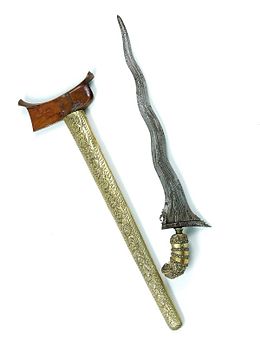Keris
| Kris ꦏꦼꦫꦶꦱ꧀ / ꦮꦁꦏꦶꦔꦤ꧀ |
|
|---|---|

The kris consists of three parts; blade (wilah), hilt (hulu) and sheath (warangka)
|
|
| Type | Dagger |
| Place of origin | Java, Indonesia |
| Service history | |
| In service | Singhasari Kingdom, Majapahit Empire, Ayutthaya Kingdom, Malaccan Empire, Demak Sultanate, Mataram Sultanate, Yogyakarta Sultanate, Surakarta Sunanate, Bruneian Empire, Sultanate of Sulu, Sultanate of Maguindanao, present day Indonesia |
| Used by |
Javanese (mainly & originally) * Also familiar to Malays, Filipinos, Sundanese, Banjar, Madurese, Balinese, Moro, Siamese, Bugis, Makassar |
| Wars | Pamalayu expedition, Mongol invasion of Java, Battle of Bubat, Majapahit civil war, Siege of Batavia, Diponegoro War, Indonesian National Revolution, Spanish-Moro Conflict, Philippine–American War, Japanese Occupation of Southeast Asia |
| Production history | |
| Produced | disputed (?) to present |
| Variants | Kalis |
| Specifications | |
| Blade type | Double edged nickelous iron or steel |
| Hilt type | Ivory, bone, horn, wooden or metals. Sometimes coated with gold or silver and decorated with gemstones |
| Scabbard/sheath | Wooden frame covered and decorated with ivory or metals (gold, silver, copper, iron, brass, or steel) |
Javanese (mainly & originally)
The kris (Ngoko Javanese: ꦏꦼꦫꦶꦱ꧀ ; Krama Javanese: ꦮꦁꦏꦶꦔꦤ꧀; Ngoko Gêdrìk: kêrìs; Krama Gêdrìk: wangkingan, lit. "to slice"; Tagalog: kalis; Bugis and Makassarese: sele) is an asymmetrical dagger with distinctive blade-patterning achieved through alternating laminations of iron and nickelous iron (pamor). While most strongly associated with the culture of Indonesia the kris is also indigenous to Malaysia, Thailand, Brunei, Singapore and the Philippines where it is known as kalis with variants existing as a sword rather than a dagger. The kris is famous for its distinctive wavy blade, although many have straight blades as well.
Kris have been produced in many regions of Indonesia for centuries, but nowhere—although the island of Bali comes close—is the kris so embedded in a mutually-connected whole of ritual prescriptions and acts, ceremonies, mythical backgrounds and epic poetry as in Central Java. As a result, in Indonesia the kris is commonly associated with Javanese culture, although other ethnicities are familiar with the weapon as part of their culture, such as the Balinese, Malays, Sundanese, Madurese, Banjar, Thais, Bugis, Makassar, and Filipinos.
...
Wikipedia
